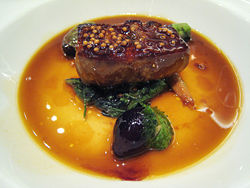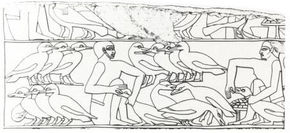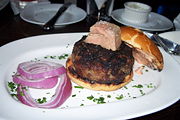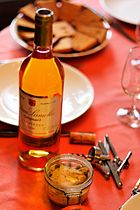Foie gras
2008/9 Schools Wikipedia Selection. Related subjects: Food
Foie gras (pronounced /fwɑːˈgrɑː/ in English; French for "fat liver") is "the liver of a duck or a goose that has been specially fattened by gavage" (as defined by French law).
Foie gras is one of the most popular and well-known delicacies in French cuisine and its flavour is described as rich, buttery, and delicate, unlike that of a regular duck or goose liver. Foie gras can be sold whole, or prepared into mousse, parfait, or pâté (the lowest quality), and is typically served as an accompaniment to another food item, such as toast or steak.
The technique of gavage dates as far back as 2500 BC, when the ancient Egyptians began keeping birds for food and deliberately fattened the birds through force-feeding. Today, France is by far the largest producer and consumer of foie gras, though it is produced and consumed worldwide, particularly in other European nations, the United States, and China.
Gavage-based foie gras production is controversial, due to the force feeding procedure, and the possible health consequences of an enlarged liver, and a number of countries and other jurisdictions have laws against force feeding or the sale of foie gras due to how it is traditionally produced.
In modern gavage-based foie gras production, force feeding takes place 12−18 days before slaughter. The duck or goose is typically fed a controlled amount of corn mash through a tube inserted in the animal's cuticle-lined esophagus.
Fattened liver can be produced by alternative methods without gavage, and this is referred to either as "fatty goose liver" or as foie gras (outside France), though it does not conform to the French legal definition, and there is debate about the quality of the liver produced. This method involves timing the slaughter to coincide with the winter migration, when livers are naturally fattened. This has only recently been produced commercially, and is a very small fraction of the market.
Foie gras production has been banned in nations such as some members of the European Union, Turkey, and Israel because of the force-feeding process. Foie gras producers maintain that force feeding ducks and geese is not uncomfortable for the animals nor is it hazardous to their health.
History
Ancient times
As early as 2500 BC, the ancient Egyptians learned that many birds could be fattened through overfeeding and began this practice. Whether they particularly sought the fattened livers of migratory birds as a delicacy remains undetermined. In the necropolis of Saqqara, in the tomb of Mereruka, an important royal official, there is a bas relief scene wherein workers grasp geese around the necks in order to push food down their throats. At the side stand tables piled with more food pellets, probably roasted grain, and a flask for moistening the feed before giving it to the geese.
The practice of geese-fattening spread from Egypt to the Mediterranean. The earliest reference to fattened geese is from the 5th century BC Greek poet Cratinus, who wrote of geese-fatteners, yet Egypt maintained its reputation as the source for fattened geese. When the Spartan king Agesilaus visited Egypt in 361 BC, he was greeted with fattened geese and calves, the riches of Egyptian farmers.
It was not until the Roman period, however, that foie gras is mentioned as a distinct food, which the Romans named iecur ficatum; iecur means liver and ficatum derives from ficus, meaning fig in Latin. The emperor Elagabalus fed his dogs on foie gras during the four years of his chaotic reign. Pliny the Elder (1st century AD) credits his contemporary, Roman gastronome Marcus Gavius Apicius, with feeding dried figs to geese in order to enlarge their livers:
"Apicius made the discovery, that we may employ the same artificial method of increasing the size of the liver of the sow, as of that of the goose; it consists in cramming them with dried figs, and when they are fat enough, they are drenched with wine mixed with honey, and immediately killed."
– Pliny the Elder, Natural History, Book VIII. Chapter 77
Hence, the term iecur ficatum, fig-stuffed liver; feeding figs to enlarge a goose's liver may derive from Hellenistic Alexandria, since much of Roman luxury cuisine is of Greek inspiration. Ficatum was closely associated with animal liver and it became the root word for "liver" in each of these languages: foie in French, hígado in Spanish, fígado in Portuguese, fegato in Italian and ficat in Romanian, all meaning "liver"; this etymology has been explained in different manners.
Postclassical Europe
After the fall of the Roman empire, goose liver temporarily vanished from European cuisine. Some claim that Gallic farmers preserved the foie gras tradition until the rest of Europe rediscovered it centuries later, but the medieval French peasant's food animals were mainly pig and sheep. Others claim that the tradition was preserved by the Jews, who learned the method of enlarging a goose's liver during the Roman colonisation of Israel or earlier from Egyptians. The Jews carried this culinary knowledge as they migrated farther north and west to Europe.
The Judaic dietary law, Kashrut, forbade lard as a cooking medium, and butter, too, was proscribed as an alternative since Kashrut also prohibited mixing meat and dairy products. Jewish cuisine used olive oil in the Mediterranean, and sesame oil in Babylonia, but neither cooking medium was easily available in Western and Central Europe, so poultry fat (known in Yiddish as schmaltz), which could be abundantly produced by overfeeding geese, was substituted in their stead. The delicate taste of the goose's liver was soon appreciated; Hans Wilhelm Kirchhof of Kassel wrote in 1562 that the Jews raise fat geese and particularly love their livers. Some Rabbis were concerned with the kashrut dietary complications consequent to overfeeding geese, because Jewish law prohibits eating a treyf animal. The chasam sofer, Rabbi Moses Sofer, contended that it is not a treyf animal as none of its limbs is damaged. This matter remained a debated topic in Jewish dietary law until the Jewish taste for goose liver declined in the 19th century. Another kashrut matter, still a problem today, is that even properly slaughtered and inspected meat must be drained of blood before being considered fit to eat. Usually, salting achieves that; however, as liver is regarded as "(almost) wholly blood", broiling is the only way of kashering. Properly broiling a foie gras while preserving its delicate taste is an arduous endeavour few engage in seriously. Even so, there are grilled meat restaurants in Israel, such as Tel Aviv's Yehuda Avazi's, that offer grilled goose foie gras.
Gentile gastronomes began appreciating fattened goose liver, which they could buy in the local Jewish ghetto of their cities. In 1570, Bartolomeo Scappi, chef de cuisine to Pope Pius V, published his cookbook Opera, wherein he describes that "the liver of [a] domestic goose raised by the Jews is of extreme size and weighs [between] two and three pounds." In 1581, Marx Rumpolt of Mainz, chef to several German nobles, published the massive cookbook Kochbuch, describing that the Jews of Bohemia produced livers weighing more than three pounds; he lists recipes for it—including one for goose liver mousse. János Keszei, chef to the court of Michael Apafi, the prince of Transylvania, included foie gras recipes in his 1680 cookbook A New Book About Cooking, instructing cooks to "envelop the goose liver in a calf's thin skin, bake it and prepare [a] green or [a] brown sauce to accompany it. I used goose liver fattened by Bohemian Jews, its weight was more than three pounds. You may also prepare a mush of it."
Main producers
| Country | Production (tons, 2005) | % of total |
|---|---|---|
| France | 18,450 | 78.5% |
| Hungary | 1,920 | 8.2% |
| Bulgaria | 1,500 | 6.4% |
| United States | 340 (2003) | 1.4% |
| Canada (Quebec) | 200 (2005) | 0.9% |
| China | 150 | 0.6% |
| Others | 940 | 4.0% |
| Total | 23,500 | 100% |
France is the leading producer and consumer of duck and goose foie gras. In 2005, the country produced 18,450 tonnes of foie gras (78.5% of the world's estimated total production of 23,500 tonnes) of which 96% was duck liver and the rest goose liver. Total French consumption of foie gras was 19,000 tonnes in 2005. Approximately 30,000 people are members of the French foie gras industry, with 90% of them residing in the Périgord ( Dordogne), the Midi-Pyrénées régions in the southwest, and ( Alsace). The European Union recognizes the foie gras produced according to traditional farming methods (label rouge) in southwestern France with a geographical indication of provenance.
Hungary is the world's second-greatest foie gras "Libamáj" producer and the largest exporter (1,920 tonnes in 2005). France is the principal market for Hungarian foie gras; mainly exported raw. Approximately 30,000 Hungarian goose farmers are dependent on the foie gras industry. French food companies spice, process, and cook the foie gras so it may be sold as a French product in its domestic and export markets.
Bulgaria produced 1,500 tons of foie gras in 2005; Québec, Canada, also has a thriving foie gras industry; Canadian chefs use Québec foie gras as a demonstration of national pride. The demand for foie gras in the Far East is such that China has become a sizeable producer; however, Chinese foie gras is viewed with some suspicion by the French.
Forms of foie gras
In France, foie gras exists in different, legally-defined presentations, from the expensive to the cheap:
- foie gras entier (whole foie gras), made of one or two whole liver lobes; either cooked (cuit), semi-cooked (mi-cuit), or fresh (frais);
- foie gras, made of pieces of livers reassembled together;
- bloc de foie gras, a fully-cooked, molded block composed of 98% or more foie gras; if termed avec morceaux ("with pieces"), it must contain at least 50% foie gras pieces for goose, and 30% for duck.
Additionally, there exist pâté de foie gras; mousse de foie gras (both must contain 50% or more foie gras); parfait de foie gras (must contain 75% or more foie gras); and other preparations (no legal obligation established).
Fully cooked preparations are generally sold in either glass containers or metal cans for long-term preservation. Whole, fresh foie gras is usually unavailable in France, except in some producers' markets in the producing regions. Frozen whole foie gras sometimes is sold in French supermarkets.
Whole foie gras is readily available from gourmet retailers in Quebec, the United States, Hungary, Australia, Argentina and regions with a sizable market for the product. In US, raw foie gras is classified as Grade A, B or C, with Grade A typically being the best for searing.
Production methods
The physiological basis of foie gras production is migratory birds' capacity for weight gain, particularly in the liver, in preparation for migration. Moulard ducks are the most commonly used breed for foie gras. Moulards are a cross breed between a male muscovy duck and a female pekin duck. Moulard ducks do not exhibit pre-migratory gorging instincts because neither the Pekin nor the muscovy are migratory birds.
Typical foie gras production involves force-feeding birds more food than they would eat in the wild, and much more than they would voluntarily eat domestically. The feed, usually corn boiled with fat (to facilitate ingestion), deposits large amounts of fat in the liver, thereby producing the buttery consistency sought by the gastronome.
Physiology and preparation
The geese and ducks used in foie gras production are, generally, Toulouse geese, and sterile hybrid ducks— Cairina moschata drakes crossed with female domestic ducks (Anas platyrhynchos). Geese and ducks are omnivorous, and, like many birds, have expansive throats allowing them to store large amounts of food, either whole or pre-digested, in the esophagus while awaiting digestion in the stomach, similar to python feeding. In the wild this dilation allows them to swallow large foodstuffs, such as a whole fish, for a later, long digestion. Wild geese may consume 300 grams of protein and another 800 grams of grasses per day. Farmed geese allowed to graze on carrots adapt to eat 100 grams of protein, but may consume up to 2500 grams of the carrots per day. A wild duck may double its weight in the autumn, storing fat throughout much of its body and especially on the liver, in preparation for winter migration. Force feeding produces a liver that is six to ten times its ordinary size. Storage of fat in the liver produces steatosis of the liver cells.
The geese or ducks used in foie gras production are usually kept in a building on straw for the first four weeks, then kept outside for some weeks, feeding on grasses that toughen the esophagus. The birds are then brought inside for gradually longer periods while introduced to a high starch diet. The next feeding phase, which the French call gavage or finition d'engraissement, or "completion of fattening", involves forced daily ingestion of controlled amounts of feed for 12 to 15 days with ducks and for 15 to 18 days with geese. During this phase ducks are usually fed twice daily while geese are fed up to 4 times daily.
Fattening
In modern production, the bird is typically fed a controlled amount of feed, depending on the stage of the fattening process, its weight, and the amount of feed it last ingested. At the start of production, a bird might be fed a dry weight of 250 grams (9 oz) of food per day, and up to 1,000 grams (35 oz) (in dry weight) by the end of the process. The actual amount of food force-fed is much greater, since the birds are fed a mash whose composition is about 53% dry and 47% liquid (by weight).
The feed is administered using a funnel fitted with a long tube (20–30 cm long), which forces the feed into the animal's esophagus; if an auger is used, the feeding takes about 45 to 60 seconds. Modern systems usually use a tube fed by a pneumatic pump; with such a system the operation time per duck takes about 2 to 3 seconds. During feeding, efforts are made to avoid damaging the bird's esophagus, which could cause injury or death.
Alternative production
While force feeding is required to meet the French legal definition of "foie gras", producers outside of France do not always force feed birds in order to produce fattened livers that they consider to be foie gras, instead allowing them to eat freely, termed ad libitum. Interest in alternative production methods has grown recently due to ethical concerns in gavage-based foie gras production. Such livers are alternatively termed fatty goose liver, ethical foie gras, or humane foie gras, though these latter terms are also used for gavage-based foie gras production that is more concerned with the animal's welfare (using rubber hoses rather than steel pipes for feeding). Award-winning Spanish producer Patería de Sousa produces foie gras under the brand Ganso Ibérico by taking advantage of the natural instinct of geese to fatten their livers in preparation for migration, which results in a seasonal product, as slaughter can only happen in winter, prior to migration. Others have expressed skepticism at these claims of humane treatment, as earlier attempts to produce fattened livers without gavage have not produced satisfactory results. In 2006, Schiltz Goose Farms began developing non-force-fed fatty goose livers by similar seasonal methods, producing their first "fatty goose livers" in 2007, with sizes two to three times that of normal goose livers (by comparison with up to six times for force-fed geese).
Preparations
Generally, French preparations of foie gras are over low heat, as fat melts faster from the traditional goose foie gras than the duck foie gras produced in most other parts of the world. American and other New World preparations, typically employing duck foie gras, have more recipes and dish preparations for serving that foie gras hot, rather than cool or cold.
The recent (in French culinary tradition) introduction of duck foie gras has resulted in some recipes returning to France from America. In Hungary, goose foie gras traditionally is fried in goose fat, which is then poured over the foie gras and left to cool; it also is eaten warm, after being fried or roasted, with some chefs smoking the foie gras over a cherry wood fire.
In other parts of the world foie gras is served in exotic dishes such as foie gras sushi rolls, in various forms of pasta or alongside steak tartare or atop a steak as a garnish.
Cold preparations
Traditional low-heat cooking methods result in terrines, pâtés, parfaits, foams and mousses of foie gras, often flavored with truffle, mushrooms or brandy such as Cognac or Armagnac. These slow-cooked forms of foie gras are cooled and served at or below room temperature.
In a very traditional form of terrine, au torchon ("in a towel"), a whole lobe of foie is molded, wrapped in a towel and slow-cooked in a bain Marie.
Raw foie gras is also cured in salt ("cru au sel"), served slightly chilled.
Given the high fatty content, foie gras can be converted into a savory ice cream, typically crusted with coarse salt.
Hot preparations
Given the increased internationalization of cuisines and food supply, foie gras is increasingly found in hot preparations not only in the United States, but in France and elsewhere. Duck foie gras ("foie gras de canard") has slightly lower fat content and is generally more suitable in texture to cooking at high temperature than is goose foie gras ("foie gras d'oie"), but chefs have been able to cook goose foie gras employing similar techniques developed for duck, albeit with more care.
Raw foie gras can be roasted, sauteed, pan-seared (poëllé) or (with care and attention), grilled. As foie gras has high fat content, contact with heat needs to be brief and therefore at high temperature, lest it burn or melt. Optimal structural integrity for searing requires the foie gras to be cut to a thickness between 15 and 25 mm, resulting in a rare, uncooked centre. Some chefs prefer not to devein the foie gras, as the veins can help preserve the integrity of the fatty liver. It is increasingly common to sear the foie gras on one side only, leaving the other side uncooked. Practitioners of molecular gastronomy such as Heston Blumenthal of the Fat Duck restaurant first flash-freeze foie gras in liquid nitrogen, with the searing process resulting in a piece at room temperature.
Hot foie gras requires minimal spices; typically black pepper, paprika (in Hungary) and salt. It has become fashionable in 3-star restaurants to use artisanal coarse salt to provide a visual and textural garnish.
Accompaniments
Foie gras may be flavored with truffles, prunes, or liquors such as Armagnac and Cointreau.
Most presentations of foie gras match it to a sweet fruit, including quince, pears, apples, prunes, plums, cherries, raspberries, blackcurrants, huckleberries, figs or elderberries. These can be in the form of sauces, coulis, jam, stewed, caramelized or pureed.
Chefs have been experimenting with various other contrasting and strong, supporting savory flavours, ranging from red beets to onion chutneys to sweet corn and peas to various mushrooms including morels or cepes to bittersweet chocolate molés.
Sauces include onion or leek-based sauces, red wine or fortified red wine reductions, truffle and mushroom sauces or wasabi drizzles.
It is commonly served accompanied with crusty or toasted bread such as a brioche, or, more rustically, toasted baguette ends.
Wine matching is traditionally a late-harvest, Botrytised dessert wine such as Sauternes, Vin de paille ( a savory Jura wine), Tokay or new-world late harvest wine, as the rich, sweet flavours go well together; classic wine and food matching. Some diners prefer foie gras with a spicy white wine, such as a Gewurtztraminer from Alsace. When foie gras is served with stronger sauces such as port-wine reductions or bitter chocolate sauces, a fortified wine such as Port or Banyuls is in order. Other dessert wines can match foie gras, including Jurançon wines from Béarn, or a Muscat grape such as Muscat de Beaumes-de-Venise, or an ice wine, ice cider, or sweet Champagne wines. When foie gras is served with truffles, mushrooms or other earthy-type flavours, it can be paired with a red burgundy wine or burgundy-style Pinot Noirs.
Accompaniments may include caramelized onions, onion jam, cornichons and Sauternes jelly.
Consumption
Foie gras is a luxury dish. Many in France only consume foie gras on special occasions, such as Christmas or New Year's Eve réveillon dinners, though the recent increased availability of foie gras has made it a less exceptional dish. In some areas of France foie gras is eaten year-round.
Duck foie gras is the slightly cheaper and, since a change of production methods in the 1950s, by far the most common kind, particularly in the US. The taste of duck foie gras is often referred to as musky with a subtle bitterness. Goose foie gras is noted for being less gamey and smoother, with a nuttier flavor.
Controversy
Animal rights and welfare groups such as PETA, Farm Sanctuary and the Humane Society of the United States contend that foie gras production methods, and force feeding in particular, constitute cruel and inhumane treatment of animals. Specific complaints include livers swollen to many times their normal size, impaired liver function, expansion of the abdomen making it difficult for birds to walk, death if the force feeding is continued, and scarring of the esophagus. PETA claims that the insertion and removal of the feeding tube scratch the throat and the esophagus, causing irritations and wounds and thus exposing the animal to risk of mortal infections.
In June 2007, research uncovered a possible link between foie gras and Amyloidosis-related disorders (including Creutzfeldt-Jakob Disease, type II diabetes and rheumatoid arthritis). Transgenic mice with predisposition to amyloidosis were either fed or injected with amyloid protein extracted from commercial foie gras. Animals in both groups displayed "extensive systemic pathological (amyloid) deposits". After cooking the foie gras per manufacturer specification, mice injected with its extracted amyloid showed reduced but still noticeable effect. The authors conclude that exposure to serum amyloid A in foie gras is the likely cause, and suggest it could be a contributing factor of certain diseases in a susceptible population.
Some research exists which suggests that excessive consistent foie gras consumption "may be linked to the onset of diseases including Alzheimer’s, type 2 diabetes and rheumatoid arthritis." However, the research is disputed and a correlation between foie gras consumption and these diseases has not been confirmed.





